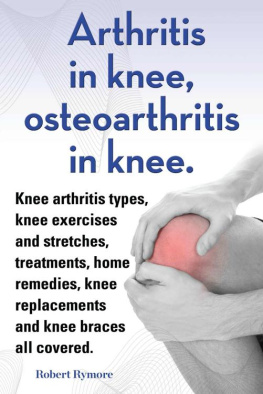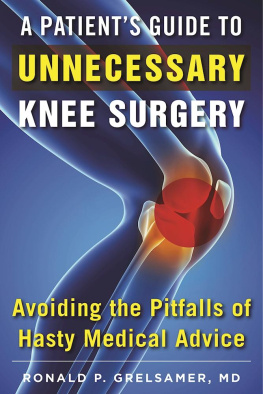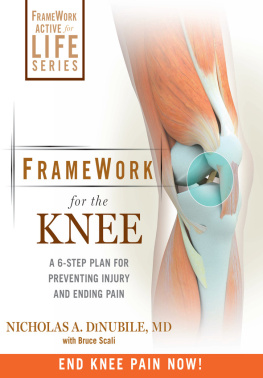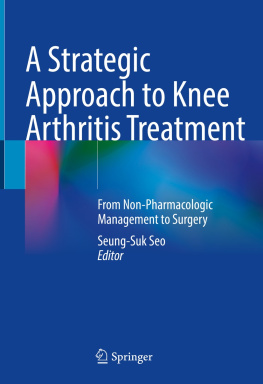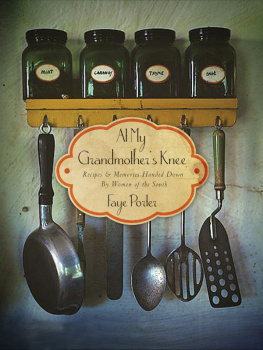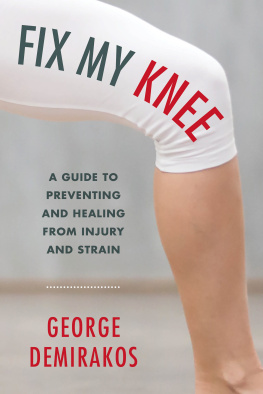Arthritisin the knee, osteoarthritis in the knee.
Kneearthritis types, knee exercises and stretches, treatments, home remedies, kneereplacements and knee braces all covered.
by
Robert Rymore
Publishedby IMB Publishing 2013
Copyrightand Trademarks. This publication is Copyright 2013 by IMB Publishing. Allproducts, publications, software and services mentioned and recommended in thispublication are protected by trademarks. In such instance, all trademarks ©right belong to the respective owners.
Allrights reserved. No part of this book may be reproduced or transferred in anyform or by any means, graphic, electronic, or mechanical, includingphotocopying, recording, taping, or by any information storage retrievalsystem, without the written permission of the author. Pictures used in thisbook are either royalty free pictures bought from stock-photo websites or havethe source mentioned underneath the picture.
Disclaimerand Legal Notice. Thisproduct is not legal or medical advice and should not be interpreted in thatmanner. You need to do your own due-diligence to determine if the content ofthis product is right for you. The author and the affiliates of this productare not liable for any damages or losses associated with the content in thisproduct. While every attempt has been made to verify the information shared inthis publication, neither the author nor the affiliates assume anyresponsibility for errors, omissions or contrary interpretation of the subjectmatter herein. Any perceived slights to any specific person(s) ororganization(s) are purely unintentional.
We have no control over the nature,content and availability of the web sites listed in this book. The inclusion ofany web site links does not necessarily imply a recommendation or endorse theviews expressed within them. IMB Publishing takes no responsibility for, andwill not be liable for, the websites being temporarily unavailable or beingremoved from the internet. The accuracy and completeness of information provided hereinand opinions stated herein are not guaranteed or warranted to produce anyparticular results, and the advice and strategies, contained herein may not besuitable for every individual. The author shall not be liable for any lossincurred as a consequence of the use and application, directly or indirectly,of any information presented in this work. This publication is designed toprovide information in regards to the subject matter covered.
Disclaimer
Information in this book has been written bythe author to serve a purpose of informing and educating the reader on kneearthritis. The author and/or publisher do not take any responsibility for theaccuracy, precision and quality of the information contained herein. The authordeclares the use of any information contained in this book to be the readersresponsibility and call.
The websites, medications, serviceproviders, books, and other mentioning of brand names in this book does notmean recommendation or endorsement by the author and/or publisher. Theirmention is for sharing information with the reader pertaining to kneearthritis. Any repercussions occurring due to the use of these aforementionedis the readers liability.
Any medication, treatment and suggestionsused in this book are not intended for self-diagnosis and treatment. Consultyour doctor for any medical enquiries and complaints. Failure to abide by theterms of use of this book and consequences resulting from this are the readersaccountability.
Furthermore,distribution and/or use of copyrighted information in this book without theauthors permission is prosecutable by law.
Table of Contents
Preface
Robert Rymore is a researcher on medicalsubjects. He writes medical educational books in a relaxed, easy-to-understandway. This book on knee arthritis is one of his many, which are written for thesole purpose of educating the reader.
Having had knee arthritis hit one of his ownhas prompted Roberts writing of this particular book. His aunt Lucy is a69-year-old lady, somewhat overweight. She developed osteoporosis early due tohaving had both her ovaries and uterus removed at the age of 40. For 3 yearsnow, she suffers from severe osteoarthritis in both of her knees, and wasunable to walk due to severe pain. She tried almost all availablepain-relieving treatment modalities up until 4 months ago, when she had a totalknee replacement on her right knee. Currently she is doing well, continuingwith physiotherapy, pain relief treatment and is waiting for her specialistsgo-ahead on surgery of the other knee.
Millions of people are struggling with kneearthritis. Roberts experience with a close family member has heightened hisefforts to dig deep into many archives to research about knee arthritis. Anyother individuals that may be in the same situation as Roberts aunt willbenefit from this book.
This knee arthritis guide covers severaltypes of knee arthritis. The development, symptoms, and treatment options forrheumatoid arthritis, osteoarthritis, gout arthritis, septic arthritis andpost-traumatic arthritis, specifically for the knee are included. It is a verywell researched and informative guide to anyone looking for answers on kneearthritis.
Foreword
My longtime colleague Robert has donejustice to this book, as he always does to all his published books. Afterreading this books draft, I can say that he covered everything that anyonelooking for information on knee arthritis should know about. This particularbook on knee arthritis is of personal interest to me; having an early form ofarthritis in my left knee, I will surely try the tips and suggestions in thisbook. Great work, Robert, and thank you for coming through with this read at myexact time of need.
Susan Turner
Medical researcher
London, 2013
Acknowledgements
This book is dedicated to my aunt Lucy, whohas been an inspiration of braveness and courage. My gratitude also extends tomy proofreader, my typist and secretary, for their excellent work. Lastly, tomy family, I glow because of your love and support.
Introduction
The Center for Disease Control andPrevention (CDC) in 2007-2009 has estimated arthritis to be the most commoncause of disability. In their data sheet for the same period of time,approximately 49.9 million U.S. adults were reported to have been diagnosed bya doctor with having arthritis. This accounted for about 22.2 % of thepopulation, and an estimated $128 billion in annual medical costs.
Also in the community are some people whohave self-diagnosed arthritis, making the 22.2% prevalence a fraction of thepossible actual statistics. The high costs of medical care, and the reducedproductivity that results from the high rate of disability, is a great burdenon the economy.
Arthritis affects mostly adults, from around30 years of age and more, although young age groups can also be affected.Female gender has a 2-3 times risk for the development of arthritis in alifetime, in comparison to the male gender. In general, arthritis can strikeanyone at any time regardless of their age, ethnicity, stamina and geographicallocation. Some risk factors, however, may alter the prevalence of this medicalcondition. Obesity is one of the risk factors of arthritis development, whichoccurs at double the rate in an obese individual when compared to those who areof normal weight.
Different kinds of arthritis exist,differentiated by their pathological development and location. Rheumatoidarthritis, osteoarthritis, gout arthritis, post-traumatic arthritis and septicarthritis are the kinds that are going to be discussed in this book, specifiedto the knee joint.
In a 2013 report, the Arthritis Research UKPrimary Care Centre has analyzed the data of people who consulted about osteoarthritisin general practice over a period of 7 years. It is estimated thatapproximately 8.75 million people in the U.K. sought treatment forosteoarthritis. The impact of arthritis is so grave that the Arthritis Societyhas estimated more Canadians to have died from arthritis than from HIV/AIDS,asthma and melanoma. Arthritis symptoms include pain, difficulties in walkingand working, with general body illness causing disability.

